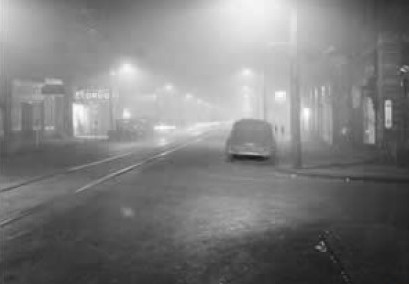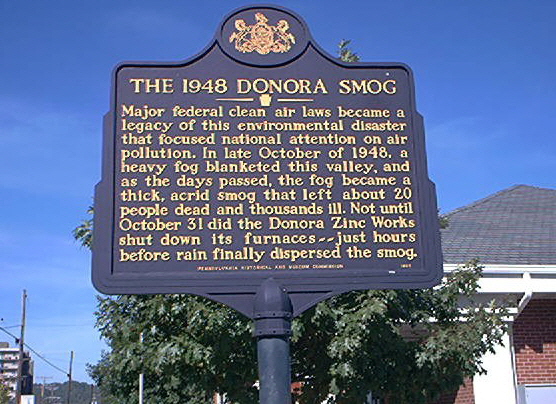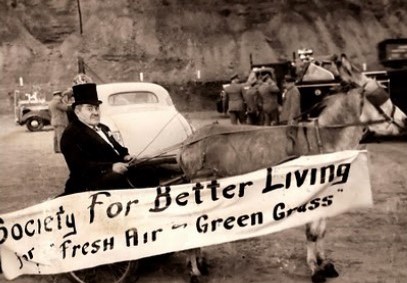As Halloween morning dawned on Donora in 1948, twenty people lay dead while half of the town’s population was sick. Within the next month, fifty more people would die because of the incident and the death rate in the town would remain elevated for decades to come.
The Donora Zinc Works had always been the epicenter of a one-mile-wide dead zone in which plants could not grow. It had opened in 1915 and three years later its parent company, the American Steel & Wire Company, paid off the first legal judgement against it for harming the population’s health.

Smoke from The Donora Zinc Works. From the Donora Smog Event, from PA SHPO files.
In the years leading up to the incident, the people of Donora and the neighboring town of Webster asserted that something from the Zinc Works was causing crops and livestock to die. In an effort to make the region habitable, dozens of local families banded together to bring legal charges against the Zinc Works for damages to their health. But the company was able and willing to undergo drawn-out legal proceedings to bury the claims against their facility.
In the meantime, the Zinc Works made some effort to mitigate the effects the facility was having on the region. They distributed limestone to local farmers to neutralize soil that was too acidic for crops and attempted to adapt their smelting furnaces to reduce smoke. But the truth was something dangerous was coming out of the Zinc Works and it could not be covered up forever.
On October 27th of 1948, a fog settled over the borough of Donora and people started to find it difficult to breathe. As the week progressed, the fog became denser and the sun was completely blocked out so that the streetlights had to be turned on in the middle of the day. Evacuation became impossible. A member of the Board of Health had to lead an ambulance through the darkened streets by foot so that it could transport the dead and dying to hospitals or a morgue.

Photo taken at noon during the Smog Event depicting the need for daytime streetlights. From the PA SHPO files.
It was clear that this dense fog was more than a natural phenomenon; this fog left a coating of sticky residue on everything it touched.
The incident would become known as the Donora Smog Event. There is a Pennsylvania Historical Marker about the event, and in 2009, portions of Donora Borough and neighboring Rostraver Township were identified as eligible for listing in the National Register of Historic Places (Key #156362).

Pennsylvania Historical Marker about the 1948 Donora Smog.
Many of the town’s residents immediately identified the Zinc Works as the source of the disaster; they were very familiar with the facility’s pollution. Families of the Zinc Works’ employees underreported their illnesses in an attempt to protect the facility.
Representatives from the Zinc Works blamed the disaster on inclement weather. The representatives argued that natural factors had concentrated the facility’s pollutants to deadly levels and that the Zinc Works was not at fault. American Steel & Wire asserted that the smog had been an ‘Act of God.’
It was true that a layer of warm air in the atmosphere had prevented the Zinc Works’ smoke and chemicals from escaping into the upper atmosphere. However, this natural weather event would have passed without attracting the world’s attention if it hadn’t been for the sulfurous fumes and heavy metal dusts that the facility unleashed on the town.
A lack of scientific understanding of air pollution and its effects on public health crippled efforts to formally identify the cause of the smog disaster. At the time, there was no standard for measuring air quality and estimation techniques could not be agreed upon by the numerous organizations investigating the disaster.
The U.S. Public Health Service (USPHS) was tasked with examining the disaster and its effects on the region. However, the agency was politically cautious and focused its study on the effects the smog had on health rather than on the source of the deadly smog. This enabled USPHS to avoid being cited as evidence for the necessity of industry regulation. Their report concluded that the smog had been deadly due to the inclement weather, pre-existing respiratory and heart diseases, and fumes from many sources including automobiles.
This report helped protect the Zinc Works from significant legal consequences. American Steel & Wire ended up paying approximately $235,000 in total to 80 smog victims who had brought a lawsuit against the company. This payment barely covered their legal expenses.
As a compromise between industry and public health, it was recommended that a warning system be established to identify similar weather conditions in the future so that the Zinc Works could reduce production and pollutants during inclement weather. Borough officials realized that they could not push for local regulation of air pollution without support from state or federal agencies because the company’s officials would rather close the facility than make expensive changes to it. Consequently, the borough accepted the implementation of the weather warning system with continued operation of the facility in order to avoid collapsing the local economy.

A Member of the Society for Better Living. From the PA SHPO files.
Despite the lack of federal action immediately following Donora’s deadly smog event, the incident became part of the national conversation about air pollution as the public pushed for smoke control regulations.
In 1955 the Air Pollution Control Act became the first U.S. federal legislation pertaining to air pollution. This Act declared air pollution to be a danger to public health and welfare and provided federal funding for research on air pollution.
After the Clean Air Act was established in 1963 to create a federal program to research methods for monitoring and controlling air pollution and then amended in 1965 to provide the first federal standards for controlling the emission of pollutants, the Environmental Protection Agency (EPA) was established in 1970 to consolidate federal efforts to research, monitor, set, and enforce standards that ensure environmental protection.
Since its creation, the EPA has labored to prevent another industrial pollution disaster like the Donora Smog Event.
Today’s guest contributor is Katherine Thorwart. Katherine is an independent contractor working on the PA SHPO’s Digitization Project with JMT. She is currently working on obtaining her Master’s Degree in Applied Archaeology from the Indiana University of Pennsylvania.
Comment Policy
PHMC welcomes and encourages topic-related comments on this blog. PHMC reserves the right to remove comments that in PHMC’s discretion do not follow participation guidelines.
Commenters and Comments shall be related to the blog post topic and respectful of others who use this site.
Commenters and Comments shall not: use language that is offensive, inflammatory or provocative (this includes, but is not limited to, using profanity, obscene, or vulgar comments); disparage other commenters or people; condone illegal activity; identify the location of known or suspected archeological sites; post personal information in comments such as addresses, phone numbers, e-mail addresses or other contact details, which may relate to you or other individuals; impersonate or falsely claim to represent a person or an organization; make any commercial endorsement or promotion of any product, service or publication.
If you would like to comment on other topics not related to this blog post but related to PHMC, please fill out the PHMC Contact Us Form.
Act of God, eh? Why would God do this?
Thank God for the EPA.